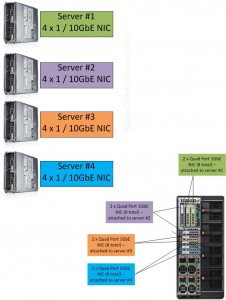I recently had a customer looking for 32 Ethernet ports on a 4 server system to drive a virtualization platform. At 8 x 1GbE per compute node, this was a typical VMware virtualization platform (they had not moved to 10GbE yet) but it’s not an easy task to perform on blade servers – however the Dell PowerEdge VRTX is an ideal platform, especially for remote locations.
 The Dell PowerEdge VRTX infrastructure holds up to 4 compute nodes and allows for up to 8 x PCIe cards. The unique design of the Dell PowerEdge VRTX allows a user to run up to 12 x 1GbE NICs per server by using a 4 x 10GbE Network Daughter Card on the Dell PowerEdge M620 blade server and then adding in two 4-port 1GbE NICs into the PCIe slots. The 4 x 1GbE NICs via the LAN on Motherboard plus 8 x 1GbE ports via the PCIe cards offers a total of 12 x 1GbE NICs – per compute node (see image for details) – which should be more than enough for any virtualization environment. As an added benefit, since the onboard LOM is a 1/10GbE card users will be able to seamlessly upgrade to 10GbE by simply replacing the 1GbE switch with a 10GbE when it becomes available later this year.
The Dell PowerEdge VRTX infrastructure holds up to 4 compute nodes and allows for up to 8 x PCIe cards. The unique design of the Dell PowerEdge VRTX allows a user to run up to 12 x 1GbE NICs per server by using a 4 x 10GbE Network Daughter Card on the Dell PowerEdge M620 blade server and then adding in two 4-port 1GbE NICs into the PCIe slots. The 4 x 1GbE NICs via the LAN on Motherboard plus 8 x 1GbE ports via the PCIe cards offers a total of 12 x 1GbE NICs – per compute node (see image for details) – which should be more than enough for any virtualization environment. As an added benefit, since the onboard LOM is a 1/10GbE card users will be able to seamlessly upgrade to 10GbE by simply replacing the 1GbE switch with a 10GbE when it becomes available later this year.
If you have a remote environment, or even a project that needs dedicated server/storage/networking, I encourage you to take a look at the Dell PowerEdge VRTX. It’s pretty cool, and odds are, your Dell rep can help you try one out at no charge.
For full details on the Dell PowerEdge VRTX, check out this blog post I wrote in June 2013.
Kevin Houston is the founder and Editor-in-Chief of BladesMadeSimple.com. He has over 17 years of experience in the x86 server marketplace. Since 1997 Kevin has worked at several resellers in the Atlanta area, and has a vast array of competitive x86 server knowledge and certifications as well as an in-depth understanding of VMware and Citrix virtualization. Kevin works for Dell as a Server Sales Engineer covering the Global Enterprise market.
Disclaimer: The views presented in this blog are personal views and may or may not reflect any of the contributors’ employer’s positions. Furthermore, the content is not reviewed, approved or published by any employer.